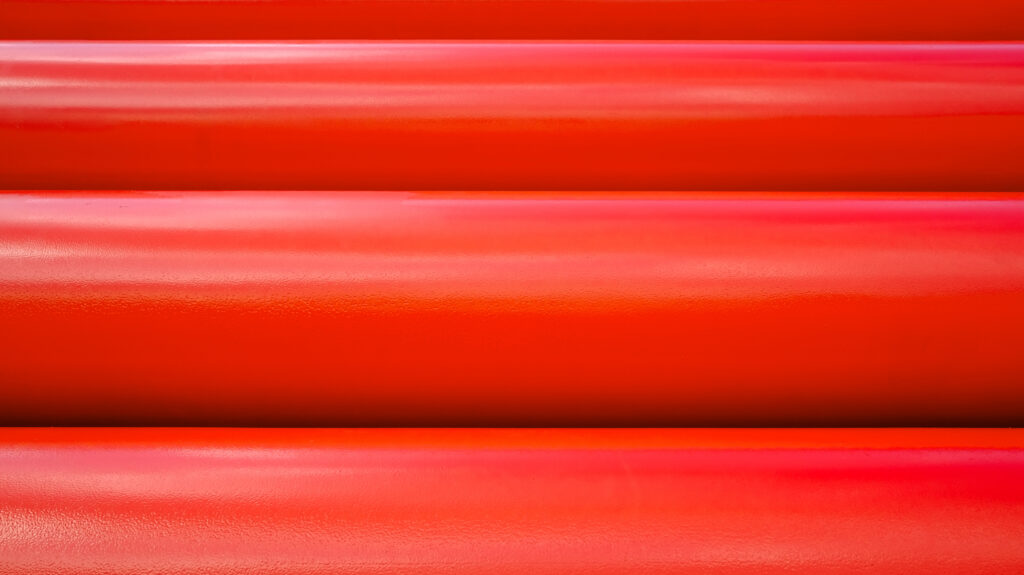Uses of thermoplastic coating
Powder coating first emerged in the late 1940s, with commercial products available since 1952, and has become ubiquitous across a range of products that we see and use every day. Thermoplastic coatings were used in those early offerings, and they have been in constant use ever since.
Thermoplastic coatings are medium-density plastic that is applied to metal objects and components, wither as a decorative or protective coating, and often both, using heat. Applied in powder form, heat melts the coating allowing it to form an even, thick finish that forms a robust layer, which will melt when reheated to aid repairs, unlike thermoset coatings.
Applying thermoplastic coating
The most common way to apply these coatings is through a process called fluidized bed dipping. Here, the metal parts are heated to between 360 and 400 degrees Celsius, depending on the precise application, and then introduced into a bed of thermoplastic powder.
The powder is agitated by compressed air blowing through it, giving it the properties of a liquid, hence the name fluidized bed coating, and this helps the coating melt around the metal object, forming a relatively thick layer of 200 microns or more covering every part of the surface.
This process was the first form of powder coating, and is still highly effective today, however other newer approaches, including electrostatic spray application are useful too. Here the powder coating is electrically charged to attract it to the metal surface, and the coated part is then heated in an oven, allowing the thermoplastic to melt and form a smooth covering.
The important aspect of application that sets thermoplastics apart is that there is no chemical change during the heating and setting process. This means that is there is an imperfection or damage, the coating can be reheated, allowing it to melt and flow to repair the problem. This is impossible with thermoset powder coatings, which do not reliquefy once set no matter how much heat is applied.
Types of thermoplastic coating
There are a number of materials used as thermoplastic coatings, including low-density polyethylene, PVC, Nylon, polypropylene, and thermoplastic polyester. Each displays unique qualities, with a choice of material depending on the application needs.
Polyethylene materials were the first to be used as powder coatings, offering high levels of corrosion resistance and extremely good electrical insulation properties/ Warm to the touch, they are often used in applications where users interact with the objects frequently, such as handles in subway cars for those standing up. The easy-clean properties and resistance to corrosive elements also make polyethylene coatings popular in lab products.
Polyvinyl coatings (PVC) usually need a primer to gain a strong bond with the object to be coated but retain the flexibility that makes them ideal for use in applications where the objects are subject to fabrication operations post coating, such as bending and drawing.
Another thermoplastic that needs a primer for best adhesion, nylon coatings are hard wearing with an extremely low coefficient of friction, and as a result are often used for bearings and other applications with moving parts.
Polypropylene is an almost completely inert compound in its natural state, and as a result, requires chemically altering to make it a useful thermoplastic coating, without which it simply cannot adhere to metal in any useful way. Once altered, it offers robust protection and similar qualities to polyethylene in terms of weather and corrosion resistance.
Finally, thermoplastic polyester has excellent adhesive properties, requiring no primer treatment, and is extremely weather-resistant, staying colorfast and withstanding the elements, making them very useful for outdoor metal furniture and similar applications.
The advantages of thermoplastic coatings
Because they can be laid down in much thicker coatings than other powder coating options, thermoplastics offer a one-layer solution for even the harshest of environments. Warm to the touch, they retain a softer feel than the hard-shell coatings and are more pleasant to interact with, which is why they are frequently found on handles, handrails, and other points of contact.
In addition, the thick, plastic coating is an excellent electrical insulator, ideal for many applications. It also makes the coated objects relatively inert in terms of temperature transmission, and you will often find items such as refrigerator shelves using thermoplastic coatings for this, as well as the excellent waterproof properties of the material.
Because the material melts and flows around the coated object, it forms a very smooth, continuous surface that is pleasant to the touch, covering corners really well, and offers a very long service life with excellent UV resistance to retain color.
Appearance options are a little limited compared to thermoset powder coatings, however with no VOC, halogen or BPA, thermoplastic coatings are environmentally responsible, a quality that is viewed with increasing importance today.
In addition, they tend to be a more cost-effective coating solution compared to alternatives, compounded by the relative speed that the coating process can be accomplished, making this an economical coating option for a broad range of applications.
Where are thermoplastic coatings used?
Powder coatings of all kinds are found everywhere, you probably interact with them every day without really noticing. However, the unique properties of thermoplastic coatings make them extremely useful in a range of applications, and you are likely to encounter them in dishwasher baskets and refrigerator shelving around the home.
In addition, metal fences are often coated in thermoplastic, including chain link and solid steel or aluminum fencing products. Handrails that have a soft, warm feel are almost certainly covered by thermoplastic coatings, while the oil and gas industry frequently use pipework with these coatings applied.
The high levels of electrical insulation on offer make these coatings an essential option for many electrical industry applications, including battery boxes, cable trays, and automotive parts. The resistance to corrosive elements such as salt also makes them suitable for many marine applications, and you will often find stadium seating using thermoplastic coatings to provide the comfortable to the touch protection they need.
Thermoplastic coatings can be used in almost every situation, offering unique properties that provide the long-lasting, good-looking protection that is needed across so many different applications.








